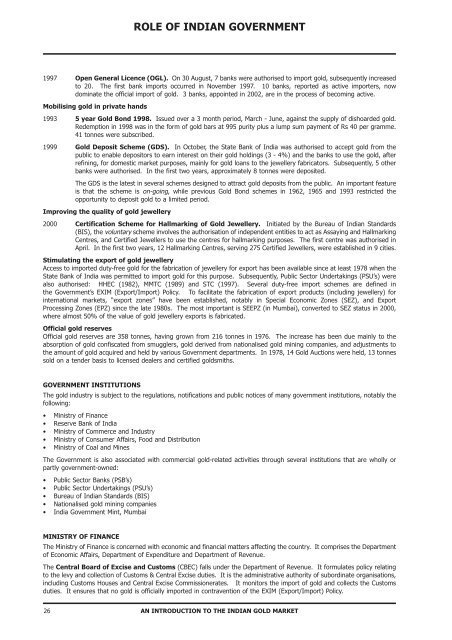Indian Gold Book:Indian Gold Book - Gold Bars Worldwide
Indian Gold Book:Indian Gold Book - Gold Bars Worldwide
Indian Gold Book:Indian Gold Book - Gold Bars Worldwide
Create successful ePaper yourself
Turn your PDF publications into a flip-book with our unique Google optimized e-Paper software.
ROLE OF INDIAN GOVERNMENT<br />
1997 Open General Licence (OGL). On 30 August, 7 banks were authorised to import gold, subsequently increased<br />
to 20. The first bank imports occurred in November 1997. 10 banks, reported as active importers, now<br />
dominate the official import of gold. 3 banks, appointed in 2002, are in the process of becoming active.<br />
Mobilising gold in private hands<br />
1993 5 year <strong>Gold</strong> Bond 1998. Issued over a 3 month period, March - June, against the supply of dishoarded gold.<br />
Redemption in 1998 was in the form of gold bars at 995 purity plus a lump sum payment of Rs 40 per gramme.<br />
41 tonnes were subscribed.<br />
1999 <strong>Gold</strong> Deposit Scheme (GDS). In October, the State Bank of India was authorised to accept gold from the<br />
public to enable depositors to earn interest on their gold holdings (3 - 4%) and the banks to use the gold, after<br />
refining, for domestic market purposes, mainly for gold loans to the jewellery fabricators. Subsequently, 5 other<br />
banks were authorised. In the first two years, approximately 8 tonnes were deposited.<br />
The GDS is the latest in several schemes designed to attract gold deposits from the public. An important feature<br />
is that the scheme is on-going, while previous <strong>Gold</strong> Bond schemes in 1962, 1965 and 1993 restricted the<br />
opportunity to deposit gold to a limited period.<br />
Improving the quality of gold jewellery<br />
2000 Certification Scheme for Hallmarking of <strong>Gold</strong> Jewellery. Initiated by the Bureau of <strong>Indian</strong> Standards<br />
(BIS), the voluntary scheme involves the authorisation of independent entities to act as Assaying and Hallmarking<br />
Centres, and Certified Jewellers to use the centres for hallmarking purposes. The first centre was authorised in<br />
April. In the first two years, 12 Hallmarking Centres, serving 275 Certified Jewellers, were established in 9 cities.<br />
Stimulating the export of gold jewellery<br />
Access to imported duty-free gold for the fabrication of jewellery for export has been available since at least 1978 when the<br />
State Bank of India was permitted to import gold for this purpose. Subsequently, Public Sector Undertakings (PSU’s) were<br />
also authorised: HHEC (1982), MMTC (1989) and STC (1997). Several duty-free import schemes are defined in<br />
the Government’s EXIM (Export/Import) Policy. To facilitate the fabrication of export products (including jewellery) for<br />
international markets, “export zones” have been established, notably in Special Economic Zones (SEZ), and Export<br />
Processing Zones (EPZ) since the late 1980s. The most important is SEEPZ (in Mumbai), converted to SEZ status in 2000,<br />
where almost 50% of the value of gold jewellery exports is fabricated.<br />
Official gold reserves<br />
Official gold reserves are 358 tonnes, having grown from 216 tonnes in 1976. The increase has been due mainly to the<br />
absorption of gold confiscated from smugglers, gold derived from nationalised gold mining companies, and adjustments to<br />
the amount of gold acquired and held by various Government departments. In 1978, 14 <strong>Gold</strong> Auctions were held, 13 tonnes<br />
sold on a tender basis to licensed dealers and certified goldsmiths.<br />
GOVERNMENT INSTITUTIONS<br />
The gold industry is subject to the regulations, notifications and public notices of many government institutions, notably the<br />
following:<br />
• Ministry of Finance<br />
• Reserve Bank of India<br />
• Ministry of Commerce and Industry<br />
• Ministry of Consumer Affairs, Food and Distribution<br />
• Ministry of Coal and Mines<br />
The Government is also associated with commercial gold-related activities through several institutions that are wholly or<br />
partly government-owned:<br />
• Public Sector Banks (PSB’s)<br />
• Public Sector Undertakings (PSU’s)<br />
• Bureau of <strong>Indian</strong> Standards (BIS)<br />
• Nationalised gold mining companies<br />
• India Government Mint, Mumbai<br />
MINISTRY OF FINANCE<br />
The Ministry of Finance is concerned with economic and financial matters affecting the country. It comprises the Department<br />
of Economic Affairs, Department of Expenditure and Department of Revenue.<br />
The Central Board of Excise and Customs (CBEC) falls under the Department of Revenue. It formulates policy relating<br />
to the levy and collection of Customs & Central Excise duties. It is the administrative authority of subordinate organisations,<br />
including Customs Houses and Central Excise Commissionerates. It monitors the import of gold and collects the Customs<br />
duties. It ensures that no gold is officially imported in contravention of the EXIM (Export/Import) Policy.<br />
26<br />
AN INTRODUCTION TO THE INDIAN GOLD MARKET

















